Identifying authentic gemstones requires both visual inspection and scientific testing. You’ll need to examine color variations, inclusions, and light play using a 10x loupe. Check the 4 Cs—color, clarity, cut, and carat weight—as they directly impact value. Measure specific gravity to distinguish similar-looking stones, and observe natural inclusions which act as “fingerprints” of genuine gems. For items exceeding $1,000, professional appraisal offers certainty about your precious investment’s authenticity.
The Gemologist’s Eye: Visual Examination Basics
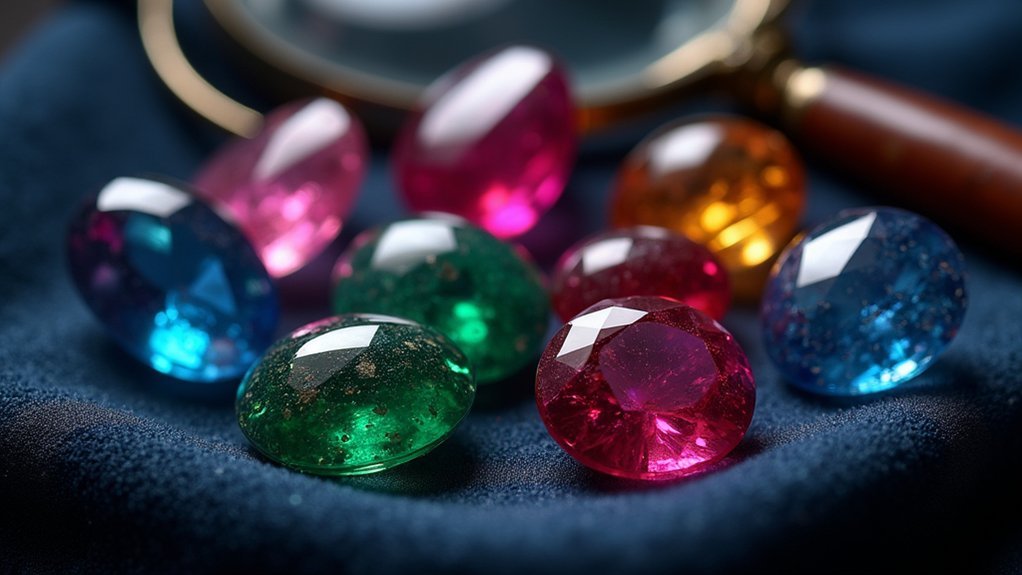
Precision defines the gemologist’s first approach to authentication. When you’re learning to identify gemstones, begin with a 10x loupe to examine the stone’s internal and external characteristics.
Look for inclusions and surface blemishes that typically appear in natural gems but are absent in synthetics.
Nature’s signature resides in the revealing flaws and subtle markings that synthetic gems cannot faithfully reproduce.
You’ll notice authentic stones display subtle color variations rather than the uniform appearance of imitations.
Don’t overlook the cut—a well-executed cut enhances the gem’s brilliance and light reflection, signaling quality craftsmanship.
Assess the luster too; genuine gems present a complex, appealing sheen that imitations struggle to replicate.
Complete your visual examination by viewing the stone under different lighting conditions. This reveals distinctive color changes and optical properties that are essential for accurate authentication and appreciation of a gem’s true character.
Mastering the 4 Cs: Color, Clarity, Cut, and Carat
The internationally recognized system of gemstone evaluation builds upon your visual examination skills, providing a standardized framework for assessment.
When examining color, look for vivid, evenly distributed hues—like the deep blue of fine sapphires—as these command premium prices in the market.
Clarity assessment involves identifying inclusions and blemishes; fewer visible flaws translate to higher value, particularly in diamonds graded VS1 or above.
Pay close attention to cut, which dramatically affects brilliance and sparkle by maximizing light return. Remember that well-cut stones often justify higher prices despite equal carat weights.
Speaking of carats, larger stones are exponentially more valuable—a single one-carat diamond typically costs more than two half-carat stones combined due to rarity.
Understanding how these four factors interact is essential for making informed purchases.
Understanding Optical Properties and Light Behavior
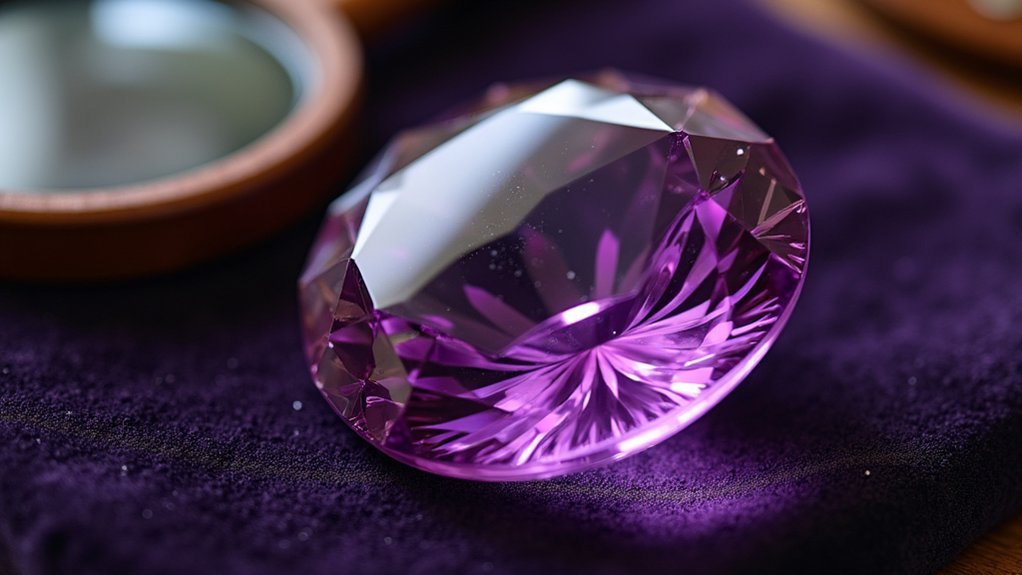
When examining gemstones beyond their surface beauty, you’ll discover that optical properties form the foundation of a gem’s allure and value. Understanding how light interacts with gemstones can help you identify authentic gems from imitations.
- Refractive index measurements reveal how much light bends when entering a gemstone—a significant identifier for authentication and gem type determination.
- Fire and dispersion create the rainbow effect seen in high-quality diamonds, where white light separates into spectral colors.
- Transparency and clarity directly impact a gem’s value—fewer inclusions allow for superior light transmission.
- Light play assessment requires examining how optical properties change under different lighting conditions; genuine stones display consistent, distinctive characteristics.
Mastering these concepts transforms you from casual observer to informed collector, capable of appreciating a gem’s true optical beauty.
Density and Specific Gravity: Weight Testing Methods
Although often overlooked by novice collectors, density measurement stands as one of gemology’s most reliable identification techniques. By determining a gemstone’s specific gravity—the ratio of its weight compared to an equal volume of water—you’ll gain critical information for identification.
| Gemstone | Specific Gravity | Identification Note |
|---|---|---|
| Diamond | 3.52 | Surprisingly light for its hardness |
| Ruby/Sapphire | 3.96-4.05 | Higher density than similar-looking stones |
| Emerald | 2.63-2.91 | Lighter than many green imitations |
To measure specific gravity yourself, weigh your clean, dry gemstone in air, then suspended in water. The difference between these measurements reveals the density characteristic. This simple test can quickly distinguish between look-alike gems that might fool visual inspection alone.
Natural Inclusions vs. Synthetic Perfection
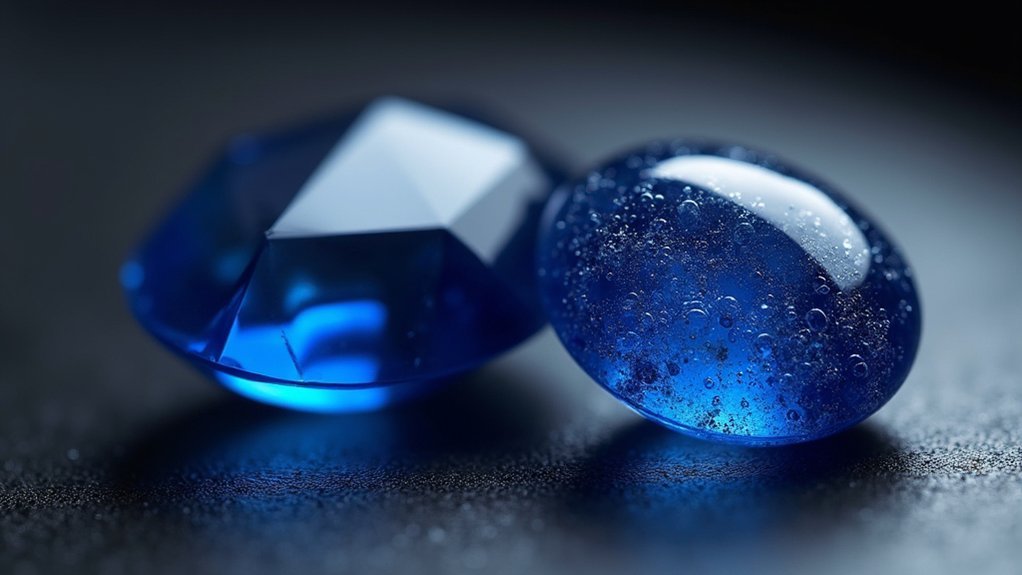
Contrary to what many novice collectors believe, perfect clarity isn’t always desirable when authenticating precious gems.
Natural inclusions serve as nature’s fingerprints, helping you verify authenticity while synthetic gems typically display flawless interiors that betray their lab-created origins.
When examining gemstones, watch for:
- Unique inclusions like mineral deposits or gas bubbles in natural stones
- Color zoning or variations in natural gems versus uniform coloration in synthetic gems
- Weight differences, as natural stones may feel lighter due to internal features
- Perfect internal structures in synthetics that lack the beautiful “flaws” that actually enhance a natural gem’s value
You’ll need proper tools like loupes or microscopes to spot these differences, as they’re often the deciding factor in authentication.
Essential Tools for At-Home Gemstone Testing
You’ll need a few basic tools to begin testing gemstones at home, including a 10x loupe for examining inclusions, a digital scale for accurate weight measurement, and soft-tip tweezers for safe handling.
For more thorough analysis, consider investing in an LED light to evaluate color properties under different lighting conditions.
A spectroscope represents a step toward advanced assessment, offering valuable insights into light patterns that can confirm a gemstone’s identity and authenticity.
Basic Testing Equipment
Successful gemstone identification at home begins with a few essential tools that won’t break the bank.
You’ll discover that effective testing techniques don’t necessarily require professional laboratory equipment. With these fundamental items, you can conduct basic gemstone identification that reveals surprising details about your specimens.
- 10x Loupe ($21-$45) – Examine inclusions and fine details that often distinguish genuine gems from imitations.
- Digital Scale ($29.95) – Accurately measure weight to determine carat and assess potential value.
- LED Light – Check how stones react to different lighting conditions, revealing true colors and potential color changes.
- Soft-Tip Tweezers ($29.95) – Handle delicate stones safely without scratching or damaging their surfaces.
A spectroscope can also help with advanced identification by revealing distinctive light patterns.
Advanced Assessment Tools
Beyond the basic equipment, serious gem enthusiasts can elevate their identification capabilities with specialized tools that reveal more complex gemstone properties. A professional-grade spectroscope analyzes light patterns passing through stones, providing critical insights into composition and detecting treatments that might affect authenticity of a gemstone.
For precise gem identification, invest in an accurate digital scale measuring in carats—this weight determination considerably impacts value assessment.
Complement your toolkit with a high-quality 10x loupe to examine inclusions and surface characteristics that often verify authenticity.
Don’t overlook the importance of proper lighting; a good LED light source reveals true colors and transparency.
Finally, use soft-tipped tweezers when handling specimens to prevent accidental damage during your detailed examinations.
The Streak Test: Revealing True Gemstone Colors
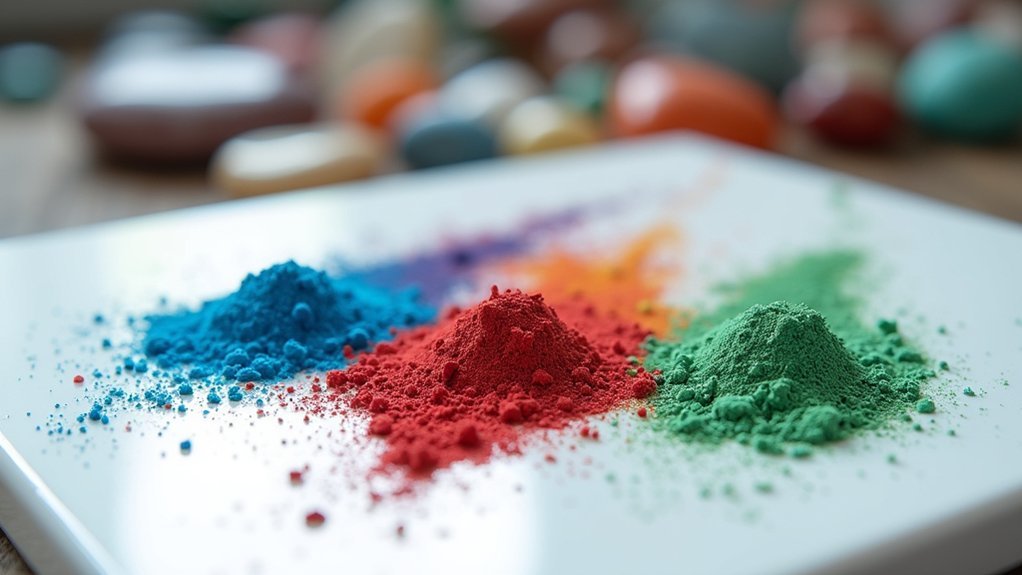
When determining a gemstone’s identity, appearances can be deceiving. The streak test offers a reliable method for identifying gemstones by revealing their true color in powdered form, which often differs from their surface appearance.
To conduct an effective streak test:
- Clean and dry your specimen thoroughly before testing.
- Draw the gemstone across an unglazed ceramic plate in one smooth motion.
- Observe the resulting powder’s color—for example, azurite leaves a light blue streak.
- Compare your results with reference charts for accurate identification.
You don’t need expensive equipment to get started. Unglazed ceramic tiles from hardware stores work well as streak plates.
This simple yet powerful technique helps you differentiate between similar-looking stones when other visual assessments prove inconclusive.
Hardness Testing: Applying the Mohs Scale
Among the most valuable tools in gemstone identification, the Mohs hardness scale offers a straightforward method for determining mineral authenticity. When you’re testing a suspicious stone, you can perform simple scratch tests using common household items to gauge where it falls on the scale of 1-10.
| Testing Material | Mohs Rating | Can Scratch |
|---|---|---|
| Fingernail | 2.5 | Talc, Gypsum |
| Glass | 5.5 | Fluorite, Apatite |
| Steel File | 6.5 | Most quartz imitations |
Every gemstone expert knows that genuine sapphires and rubies (9) will easily scratch glass but won’t mark a diamond. When conducting hardness testing, exercise caution with softer gems like opal and turquoise (5-6), as aggressive testing could damage them. This simple technique quickly exposes many imitations that don’t match their natural counterparts’ hardness properties.
Thermal and Electrical Conductivity Tests
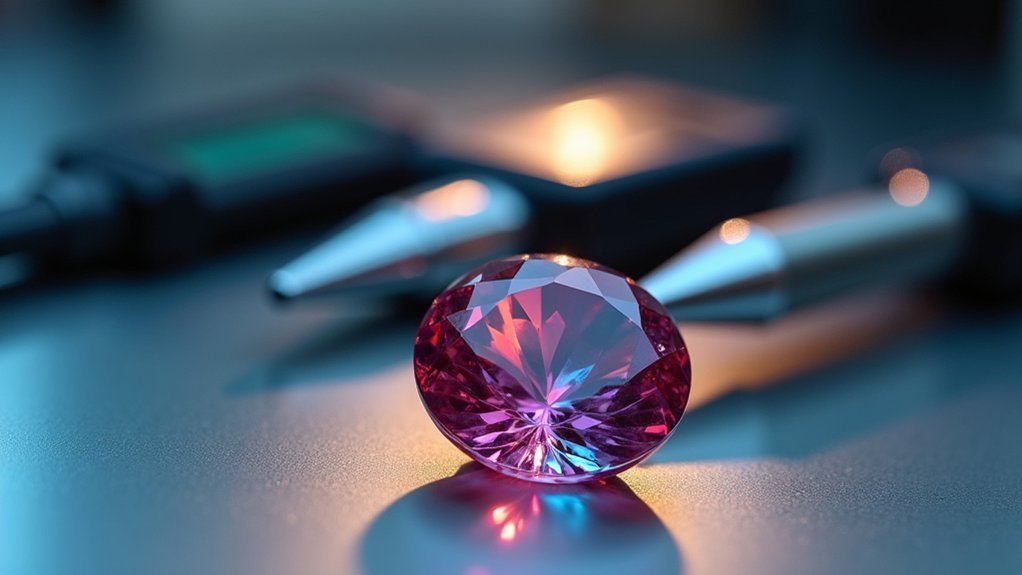
Thermal conductivity tests can quickly reveal a gemstone’s identity by measuring how efficiently it transfers heat, with diamonds showing exceptional thermal properties compared to most simulants.
You’ll find that using a professional conductivity meter provides the most accurate results, instantly distinguishing between diamonds and moissanite based on their distinctive heat transfer rates.
For a simple at-home assessment, you can place the gemstone on a warm surface and observe how quickly it cools, though this method won’t provide the precision of professional equipment.
Heat Testing Methods
Two sophisticated techniques for gemstone authentication rely on heat principles: thermal and electrical conductivity tests. When you’re looking to identify genuine gemstones, these heat testing methods provide scientific validation beyond visual inspection.
- Thermal conductivity tests measure how quickly gems absorb and release heat—diamonds dissipate heat exceptionally fast compared to simulants.
- Specialized equipment like thermal conductivity testers provide precise readings that help differentiate authentic stones from synthetics.
- Electrical conductivity testing reveals that natural diamonds act as insulators, while some synthetic versions conduct electricity.
- Thermal properties vary considerably between gem types, creating unique signatures that experts use to identify treatments and synthetics.
These scientific approaches offer reliable verification when you need absolute certainty about a gemstone’s authenticity.
Conductivity Meter Basics
Modern conductivity meters serve as essential tools in a gemologist’s arsenal, allowing for non-destructive identification of gemstones through their unique thermal and electrical properties.
You’ll find these devices particularly valuable when differentiating genuine stones from imitations.
When identifying a gemstone, you can leverage both thermal and electrical conductivity tests.
Thermal conductivity measures how quickly heat passes through the stone—diamonds conduct heat rapidly while cubic zirconia doesn’t.
Electrical conductivity helps distinguish natural gems from synthetics, as lab-created stones typically have different conductive patterns due to their uniform structure.
The beauty of using a conductivity meter lies in its immediacy—you’ll get instant results without damaging the specimen.
For maximum accuracy, combine these readings with visual inspections and other physical tests to confirm your identification.
Distinguishing Treatment and Enhancement Signs
When examining valuable gemstones, you’ll need to recognize the telltale signs that separate natural from enhanced specimens. Treatments can affect both appearance and value, with untreated stones typically commanding higher prices in the market.
The ability to distinguish natural from treated gemstones directly impacts their value and authenticity in the collector’s market.
Detecting signs of treatment often requires specialized equipment and knowledge of what to look for.
- Look for unnaturally uniform color distribution, as natural gems typically show subtle variations while treated stones display more consistent coloration.
- Examine for microscopic inclusions—natural stones usually contain minor imperfections while treated ones may show distinctive patterns.
- Check for color zoning patterns that might indicate heat treatment or irradiation.
- Seek certification from reputable gemological laboratories to confirm whether a stone has undergone enhancement procedures.
Examining Gemstone Luster and Surface Features
When examining a gemstone’s authenticity, you’ll need to assess its luster by noting whether it appears vitreous, pearly, or dull under different lighting conditions.
Check for characteristic surface features including natural inclusions, etching patterns, and imperfections that distinguish genuine stones from synthetics.
Your inspection should also reveal textural qualities—smooth surfaces typically indicate proper polishing, while uneven areas might signal lower quality or potential forgery.
Lustrous Qualities Checklist
A gemstone’s luster provides critical clues about its identity, value, and authenticity. When examining a potential gem, you’ll need to assess how light interacts with its surface to determine if you’re holding a genuine treasure or a clever imitation.
- Observe in multiple lighting conditions – Natural stones display varying luster qualities under different lights, so check in both daylight and artificial illumination.
- Look for characteristic reflections – Diamonds should have brilliant luster while opals exhibit a milky sheen.
- Examine surface imperfections – Authentic gems often contain tiny etchings or pits that synthetic counterparts lack.
- Quantify the reflectivity – Compare the stone’s luster to established scales for its purported type, as inconsistencies may signal a fake.
Surface Textures Unveiled
The tactile truth of a gemstone’s surface tells a story that trained eyes can read. When identifying authentic stones, examine surface textures like natural etching, pits, or grooves—these characteristics often distinguish genuine gems from synthetics.
You’ll want to inspect your stone under various lighting conditions. This reveals subtle variations in luster, from vitreous glass-like qualities to pearly or silky appearances.
Don’t dismiss imperfections; scratches and inclusions are actually valuable authentication markers that rarely appear in manufactured stones.
Look for unique patterns or color zoning on the surface. These features aren’t flaws but signatures of authenticity.
The presence of consistent textural characteristics within a gemstone type provides compelling evidence of its natural origin, helping you confidently determine what you’re holding.
Professional Appraisal: When to Seek Expert Opinion
Why risk misidentifying valuable gemstones when professional gemologists can provide definitive answers?
While basic identification techniques are valuable, a professional appraisal becomes essential when dealing with high-value stones. Reputable gemological laboratories offer certificates documenting your gem’s exact characteristics, from cut and color to treatments that affect value.
Amateur methods fall short when assessing precious gems—only certified gemologists can reveal their true value and authenticity.
Consider expert assessment when:
- Your gemstone’s estimated value exceeds $1,000
- You need proper documentation for insurance coverage
- You suspect treatments or enhancements that might affect value
- You’re making a significant investment and need verification
These professional evaluations provide peace of mind and protect your investment.
Rather than relying solely on your assessment skills, expert opinions guarantee you’re making informed decisions when the stakes are high.
Refractive Index and Polariscope Testing
Understanding gemstone identity with scientific precision requires mastering two essential diagnostic tools: refractive index measurement and polariscope testing.
When you measure a gem’s refractive index (RI) using a refractometer, you’re determining how light bends through its structure—a diamond’s 2.42 RI differs markedly from quartz’s 1.54-1.55, providing a reliable identification marker.
Polariscope testing reveals whether your gem is isotropic (single RI) or anisotropic (multiple RIs), helping you distinguish between natural and synthetic specimens.
By rotating the stone under polarized light, you’ll observe pleochroism, color variations that further confirm specific gem types.
Both techniques work together to identify impostors—synthetic sapphires often have slightly different RI values than their natural counterparts, exposing even well-crafted fakes.
Pricing Factors: Valuing Authentic Gemstones
When you’re evaluating a gemstone’s value, you’ll need to take into account the 4 Cs—color, clarity, cut, and carat weight—which form the foundation of any accurate appraisal.
The relationship between rarity and value is direct; less common stones like natural rubies command premium prices compared to more abundant varieties, especially when they’re untreated and set in precious metals.
You should also factor in market fluctuations driven by changing trends and economic conditions, as these factors can greatly impact both current pricing and long-term investment potential.
Value Vs Rarity Relationship
The fundamental relationship between a gemstone’s value and its rarity creates the backbone of pricing in the jewelry market.
You’ll find that scarcity directly correlates with higher prices, which explains why red diamonds command astronomical sums while quartz remains affordable despite its beauty.
When evaluating a gem’s true worth, consider these key factors:
- Natural rarity – untreated stones typically hold greater value than enhanced ones
- Market demand – trending gems can experience price surges regardless of actual scarcity
- Quality metrics – the 4 Cs considerably impact value even within the same gem variety
- Professional certification – laboratory documentation validates rarity claims and authenticity
Understanding this value-rarity connection helps you make informed purchasing decisions and recognize why certain gemstones command premium prices in the marketplace.
Understanding Market Fluctuations
Gemstone markets experience constant flux, influenced by a complex interplay of factors that can dramatically shift prices overnight. When you’re valuing real gemstones, staying informed about these fluctuations helps you make wiser investment decisions.
| Factor | Impact | Example |
|---|---|---|
| 4Cs Quality | Direct value correlation | Higher clarity commands premium prices |
| Treatments | Typically decreases value | Heat-treated sapphires worth less than untreated |
| Certification | Enhances marketability | GIA-certified stones fetch higher prices |
Supply and demand fundamentals drive the gemstone market, with rarity consistently commanding premium prices. You’ll notice economic trends affecting different gemstones uniquely—while one variety surges in popularity, another might temporarily decline. Reputable certification becomes especially vital during volatile periods, providing assurance when market confidence wavers.
The Four C’s Impact
Just as expert gemologists evaluate diamonds, they apply the four C’s—color, clarity, cut, and carat weight—to assess all precious gemstones. When you’re examining potential investments, understanding these criteria will help you identify truly valuable specimens.
- Color – Seek vibrant, evenly distributed hues in precious stones; sapphires and rubies with intense saturation command premium prices.
- Clarity – Examine for inclusions and blemishes; fewer imperfections translate to higher value.
- Cut – Assess how light interacts with the gem; well-executed cuts produce superior brilliance and greatly increase worth.
- Carat weight – Remember that larger specimens are exponentially more valuable; prices increase disproportionately as size increases.
These four factors work together to determine a gemstone’s market value, with exceptional ratings across all categories indicating truly superior specimens.
Frequently Asked Questions
How to Check Authenticity of Gemstones?
You can check gemstone authenticity by using a loupe for inclusions, measuring specific gravity, verifying certification, testing hardness on the Mohs scale, and observing how it interacts with light.
What Is the Best Tool to Identify Gemstones?
A 10x loupe is your best gem identification tool. You’ll see inclusions and clarity details clearly. For more advanced work, you’ll need a spectroscope to reveal distinctive light patterns specific to different gemstones.
How Do Gemologists Identify Gems?
Gemologists identify gems by using specialized tools like 10x loupes and refractometers. You’ll find they also measure specific gravity, assess hardness, and look for characteristic inclusions that distinguish natural stones from synthetics.
How to Tell if a Gem Is Real or Glass at Home?
You can tell if a gem is real by checking for natural inclusions, testing hardness with a scratch test, comparing weight, observing light refraction with a flashlight, and feeling its temperature against your skin.
In Summary
You’re now equipped with essential gem identification techniques, from the 4 Cs to optical testing. Remember, real gems often contain slight imperfections while synthetics appear too perfect. When you’re uncertain, don’t hesitate to consult a certified gemologist. With practice, you’ll develop a trained eye that spots authentic stones and understands their true value. Trust your knowledge, but verify with proper tools.





Leave a Reply